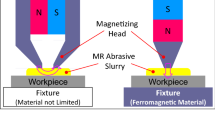Abstract
This paper presents an experimental study on the key process parameters in magnetic field-assisted finishing (MFAF), aiming to investigate the relations between the magnetic abrasives, polishing force, material removal rate (MRR) and surface roughness. The experiments were conducted using a dual magnetic roller tool combining with a 6-axis robot arm. The effect of abrasive type and size on polishing force and MRR, wear of magnetic abrasives, surface roughness and surface morphologies obtained using different types of magnetic abrasives were evaluated quantitatively. The results show that the type of SiC-based magnetic abrasives had a higher MRR but lower polishing force than that of Al2O3-based magnetic abrasives. Due to the inability of carbonyl iron powder (CIP) carrier to hold large SiC or Al2O3 particles during the rotation motion of the magnetic roller tools, large particle size abrasives have a lower MRR as well as polishing force than small particle size abrasives. The wear of magnetic abrasives was demonstrated through scanning electron microscope (SEM) observation and energy dispersive X-ray (EDX) analysis of abrasive particles before and after polishing. The surface morphologies generated by the four different experimental conditions of magnetic abrasives were different although the surface roughness achieved a similar value.
Similar content being viewed by others
References
Ezugwu EO (2005) Key improvements in the machining of difficult-to-cut aerospace superalloys. Int J Mach Tools Manuf 45(12):1353–1367
Rahman M, Seah WKH, Teo TT (1997) The machinability of Inconel 718. J Mater Process Technol 63(1):199–204
Dudzinski D, Devillez A, Moufki A, Larrouquere D, Zerrouki V, Vigneau J (2004) A review of developments towards dry and high speed machining of Inconel 718 alloy. Int J Mach Tools Manuf 44(4):439–456
Levy G, Schindel R, Kruth JP (2003) Rapid manufacturing and rapid tooling with layer manufacturing (LM) technologies, state of the art and future perspectives. CIRP Annals-Manufacturing Technology 52(2):589–609
Frazier WE (2014) Metal additive manufacturing: a review. J Mater Eng Perform 23(6):1917–1928
Gibson I, Rosen DW, Stucker B (2010) Additive manufacturing technologies. Springer, New York, pp. 1–3
Guo N, Leu MC (2013) Additive manufacturing: technology, applications and research needs. Front Mech Eng 8(3):215–243
Huang SH, Liu P, Mokasdar A, Hou L (2013) Additive manufacturing and its societal impact: a literature review. Int J Adv Manuf Technol 67(5–8):1191–1203
Murr LE, Gaytan SM, Ramirez DA, Martinez E, Hernandez J, Amato KN, Wicker RB (2012) Metal fabrication by additive manufacturing using laser and electron beam melting technologies. Journal of Materials Science & Technology 28(1):1–14
Kuriyagawa T, Zahmaty MSS, Syoji K (1966) A new grinding method for aspheric ceramic mirrors. J Mater Process Technol 62(4):387–392
Wang ZZ, Guo J Research on an optimized machining method for parallel grinding of f-θ optics. Int J Adv Manuf Technol 80(5–8):1411–1419
Walker DD, Brooks D, King A, Freeman R, Morton R, McCavana G, Kim SW (2003) The ‘Precessions’ tooling for polishing and figuring flat, spherical and aspheric surfaces. Opt Express 11(8):958–964
Guo J, Morita S, Hara M, Yamagata Y, Higuchi T (2012) Ultra-precision finishing of micro-aspheric mold using a magnetostrictive vibrating polisher. CIRP Annals-Manufacturing Technology 61(1):371–374
Guo J, Suzuki H, Higuchi T (2013) Development of micro polishing system using magnetostrictive vibrating polisher. Precis Eng 37(1):81–87
Fähnle W, van Brug H, Frankena HJ (1998) Fluid jet polishing of optical surfaces. Appl Opt 37(28):6771–6773
Jayswal SC, Jain VK, Dixit PM (2005) Modeling and simulation of magnetic abrasive finishing process. Int J Adv Manuf Technol 26(5–6):477–490
Suzuki H, Kodera S, Hara S, Matsunaga H, Kurobe T (1989) Magnetic field-assisted polishing—application to a curved surface. Precis Eng 11(4):197–202
Yin SH, Takeo S (2004) A comparative study: polishing characteristics and its mechanisms of three vibration modes in vibration-assisted magnetic abrasive polishing. Int J Mach Tools Manuf 44(4):383–390
Guo J, Kum CW, Au KH, Tan ZEE, Wu H, Liu K (2016) New vibration-assisted magnetic abrasive polishing (VAMAP) method for microstructured surface finishing. Opt Express 24(12):13542–13554
Yamaguchi H, Shinmura T (2004) Internal finishing process for alumina ceramic components by a magnetic field assisted finishing process. Precis Eng 28(2):135–142
Sato T, Kum CW (2013) Surface Polishing Apparatus, WO/2013/172785
Wang Y, Wu Y, Guo H, Fujimoto M, Nomura M, Shimada K (2015) A new magnetic compound fluid slurry and its performance in magnetic field-assisted polishing of oxygen-free copper. J Appl Phys 117.17:17D712
Sidpara A, Jain VK (2013) Analysis of forces on the freeform surface in magnetorheological fluid based finishing process. Int J Mach Tools Manuf 69:1–10
Author information
Authors and Affiliations
Corresponding author
Additional information
Highlights
1. A dual magnetic roller tool combining with a 6-axis robot arm was used to conduct the experiments.
2. The type of SiC-based magnetic abrasives had a higher material removal rate (MRR) but lower polishing force than that of Al2O3-based magnetic abrasives.
3. Due to the inability of carbonyl iron powder (CIP) carrier to hold large SiC or Al2O3 particles during the rotation motion of the magnetic roller tools, large particle size abrasives have a lower MRR as well as polishing force than small particle size abrasives.
4. The wear of magnetic abrasives was investigated through scanning electron microscope (SEM) observation and energy dispersive X-ray (EDX) analysis of abrasive particles before and after polishing.
5. The surface morphologies generated by the four different experimental conditions of magnetic abrasives were different although the surface roughness achieved a similar value.
Rights and permissions
About this article
Cite this article
Guo, J., Tan, Z.E., Au, K.H. et al. Experimental investigation into the effect of abrasive and force conditions in magnetic field-assisted finishing. Int J Adv Manuf Technol 90, 1881–1888 (2017). https://doi.org/10.1007/s00170-016-9491-6
Received:
Accepted:
Published:
Issue Date:
DOI: https://doi.org/10.1007/s00170-016-9491-6




